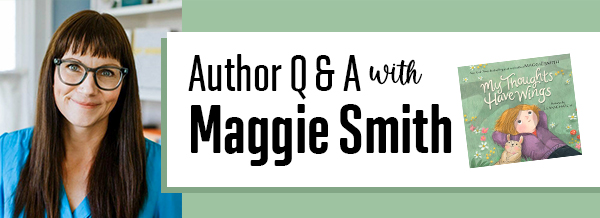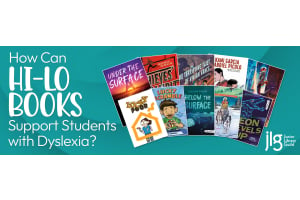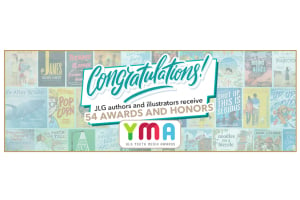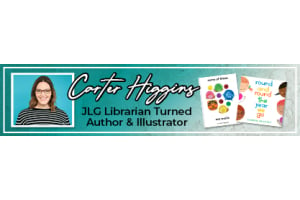Maggie Smith: Poet. NYT Bestselling Author. Past Copy Editor at JLG.


Introduction:
Maggie Smith: Poet. Loving mother. NYT Bestselling author. Past copy editor at JLG—wait, what?! In our newest blog post, you’ll learn more about why Maggie keeps receiving Harry Potter fan mail, her advice for aspiring authors, and how she keeps life poetic. You’ll even get a sneak peek at her newest projects and learn the heartwarming inspiration behind her upcoming JLG Gold Standard Selection, My Thoughts Have Wings.
“Poetry goes beyond the genre for me, instead it’s how I perceive and move through the world,” said Maggie. “I am much more of an image presenter or an experience distiller than I am a storyteller. No matter what I’m doing or writing, I’m entering it from the framework of poetry.”
Add My Thoughts Have Wings to your JLG Book Box here.
1. Maggie, tell us about yourself—your writing, your editing, your teaching, your tweeting—all of it!
I've been writing seriously since my early twenties, but I think I wrote my first poem when I was 13, and I’ve been a bookworm my whole life. I had no idea that I’d grow up to become a writer, but I always knew that I would be a reader. When I got to college, it dawned on me that writing was what I did best. I always knew I would write poems whether I made a living out of it or not.
I went to Ohio Wesleyan for my bachelor's degree in creative writing and later The Ohio State University for my MFA in poetry. After grad school, I taught at Gettysburg College in Pennsylvania for a year, but realized I didn’t get as much writing done when I was teaching as I would have liked to. Plus, my whole family and my partner at the time were in Central Ohio. My intention was always to come back—I knew I wanted to start a family and do so while remaining in my community. With a career in academia, I wasn’t sure that I’d be as rooted as I wanted to be, and I figured that I could write anywhere, right? I decided to move back to Columbus and write as much as possible, and that meant finding a job with 9-5 hours instead of doing teaching prep, grading, or responding to panicked student emails on my weekends and in my evenings. This search led me to JLG.
While working at JLG I wrote catalog copy, edited author bios, and supported the team with other writing from the Columbus office. One of the joys from this job was getting to read all the best picture books, anthologies, YA novels—books from all different age ranges. I loved that reading was a such a big part of my job—what writer doesn’t want to spend their days reading books and writing about them?
During my first year at JLG, my first collection of poems, Lamp of the Body, was published. After JLG, I had other writing-adjacent jobs where I worked in educational publishing. I was writing in the evenings and on weekends—and even during my lunch hour. I could sit at my desk, put my headphones on, and write for 45 minutes. I learned how to toggle back and forth between writing for my job and writing for myself (it was two different modes). I learned quickly not to be too concerned about the conditions I was writing in or too precious about the amount of time I had. Writing with little snippets of time in my cubicle or with my children home with me helped me build my work habits and resilience as a writer. These times made it possible for me to write in an airport, a busy coffee shop—it doesn’t matter to me where I am; I’m able to hop into that special headspace.
The Maggie who was writing poems on her lunch hour in a cubicle in her mid-twenties could not have imagined having a bestselling memoir in her mid to late forties; I never would have imagined the genres that I’d be writing in or imagined that I could truly make a living doing this. I don’t think I could have predicted what my artistic and professional life looks like now. I always remind my students that we don’t really know all that’s possible for us—that the possibilities are much wider and deeper than we can imagine for ourselves.
For the past five years I’ve been teaching at a low residency MFA program at Spalding University called the Naslund Mann Graduate School of Writing. Low residency means that while I’m in Ohio, and the university is in Kentucky, I can still be on faculty and students from all over the world can be part of this program; almost all the work we do together happens remotely.
As far as my tweeting goes, I ended up joining Twitter and Instagram around the time that my second book came out in 2015. In 2018, when I was going through my divorce, I started writing these daily notes to myself, and I had no idea when I wrote the first one that I would write one the next day, or the day after that. It wasn’t a planned project; I was holding myself accountable for having a hard time. The Internet can be so frustrating, it allows us to curate our space in a way that no one really knows what our true lives look like. It’s easy to think that you’re the only one struggling when everyone makes it looks like they have it all together. The feedback I received was amazing, like when people would tell me, “Wow, I really needed this” and then retweet my message. That's what inspired me to write my book, Keep Moving, the reader feedback being: we need these messages in a book! During Keep Moving, my poem “Good Bones” went viral on Twitter, and it’s strange to think that a lot of my professional success wouldn’t have been possible without the Internet.
2. A little birdie (yes, with wings) told us that you used to work for JLG… How does it feel to come full circle with your newest children’s book becoming a Gold Standard Selection?
It's really lovely to get nice reviews and to hear from readers that they are enjoying my books—all of that is so special. Finding out that My Thoughts Have Wings was a Junior Library Guild selection was extra special to me because it made me reflect on the earlier version of myself, the one who didn’t see this coming.
I’ve been writing for almost 20 years, and no longer being a newbie means I have these full circle moments, like going from being the grad student to being the faculty who gets to mentor grad students, or being a reader of poetry and then having your own books on a shelf in a library or bookstore. For me, having a JLG selection was incredibly cool because it was not even a dream I had. I always knew that I wanted to publish a book of poems, but when I was working at JLG, it didn’t occur to me that someday I’d write a book that would have a JLG gold seal on it. This experience speaks to the dreams that we don’t even know we have—not everything needs to be an outlined goal, right? It also makes me hopeful for the future; what will I look back on one day and say, “Maggie, you had no idea what was coming!” It remains true that we can keep surprising ourselves.
3. On the topic of writing, do you prefer writing prose or poetry? Does your writing process change when you’re writing one or the other?
Poetry is my home genre; I'll always think of myself as a poet. When I wrote my memoir, You Could Make This Place Beautiful, I wrote it as a poet, even though it’s prose. When I wrote My Thoughts Have Wings, I wrote it as a poet, too. When I'm writing essays, I write them as a poet. Frankly, I write my emails as a poet. I parent as a poet. Poetry goes beyond the genre for me, instead it’s how I perceive and move through the world; I am much more of an image presenter or an experience distiller than I am a storyteller. No matter what I’m doing or writing, I am entering it from the framework of poetry.
That’s not to say, however, that I enjoy writing a poem more than I enjoy writing prose; honestly, the process doesn’t feel too different to me. When I first get an idea, I draft longhand in a notebook or on a legal pad. It’s an unspooling of ideas, imagery, metaphors, and thoughts—and I don’t always know if it will agree to be a poem or not. Sometimes I need more space. Process-wise—in the beginning, at least—prose and poetry feel very similar when drafting; the genesis of the thing is not that different. I don’t think ideas care what form they take, as long as they become something, and that’s really what they want: to come to the surface and be out there. It’s then my job to shepherd those ideas into the world in the form that serves them best.
4. Which do you prefer to read, prose or poetry?
Some of my favorite books are actually prose written by poets, which is like walking that fine line between the two. If you look at the number of books I’ve read and then divided them by genre, you will find that I read more poetry than anything else, so, just by the number of books in the pie chart, you might infer that I enjoy reading poetry the most, but I get so much pleasure from reading novels, essay collections, and memoirs by people who are also poets. There’s something about the way they write that mimics the way my own mental process works. I don’t read to escape; instead, I’m always asking myself, “What can I learn from this book? How could I adapt this technique? What should I try next?” I always find surprises like, “Oh! I should try that…what a clever idea! I didn’t know you could do that…” I’m reading to learn from practicing writers.
5. After your successes with multiple poetry collections and your memoir, You Could Make this Place Beautiful, what led you to writing a children’s book?
I have written for kids a lot as someone who worked for educational publishers, but I hadn’t written much of my own creative work for children. After having kids and reading so much to them, I felt like I could try it. Book projects happen to me, like an idea. They tug and tug at me until it won’t go away, and then I’m sure that that’s my next idea. In the case of My Thoughts Have Wings, it was bedtime conversations with my own son.
6. My Thoughts Have Wings feels tender and cozy, like a love story. What was your inspiration for this book?
This book could be shelved as nonfiction as it is nearly verbatim the conversations I had with my own child during peak-pandemic time. My son was having a hard time falling asleep at night, both because of all the things that were really troubling kids and adults alike all over the world (like separation from friends and family) and because we had a lot of personal things happening in our house, like the divorce. It was the time when you couldn’t hug your grandparents, you couldn’t go to school, you couldn’t have fun with your peers at extracurriculars. Life was so derailed, scary, and confusing. All these things compiled did not make for an easy bedtime for a seven-year-old. My son would say that right before he laid down in bed, that all these bad thoughts would flood his mind, no matter how hard he tried to battle them with good thoughts and memories.
Throughout the day, it’s easier to push bad thoughts to the margins and focus on the task in front of you. Those big, existential things that we’re dealing with often get shoved aside or to the back of our minds, but then when we lie down at night and it’s quiet, we have less distractions and—WHOOSH! —those thoughts flood in. It happened to me, and it was happening to my son, so we came up with a practice of first validating all of our worries and fears—because they are very real. I didn’t say, “Don’t think about those things” or “Don’t worry about it,” because that doesn’t help. I sat with my child, listened to his fears, and validated them by saying, “I’m so sorry, that is so hard, and I wish I could change that for you.” Once we’d had time to sit with our feelings, we would shift to all the good things that were happening in our lives.
During this time, my son and I would talk about all the things we were looking forward to and our lists of happy memories, using all the sensory detail we could muster. My Thoughts Have Wings paints my son’s worries and his happy memories, and the best part? It worked. This routine was effective for him and made bedtimes easier. What occurred to me—the idea that kept tugging at my mind and wouldn’t go away—was that maybe this practice, this bedtime ritual, might be helpful for other families who were experiencing overactive minds and anxious bedtimes.
I hope this book is a conversation starter for children and the person reading it with them. I wanted to give kids a strategy that’s empowering, something that they could use even if a caregiver wasn’t with them: Take a second to think about what is troubling you, and then count 5 good things that are also taking place in your life. I know that the more we can support kids and help them feel calm and good about themselves, the better they’ll do in every aspect of their lives. I'm thinking about that as a parent all the time.
7. Throughout the story, the mother encourages her daughter to fill up her nest with good thoughts. Are there any good thoughts that you keep stored for times when you feel worried or anxious?
Whenever I need a happy thought, I think about my kids. If there's turbulence on a flight, or if I've just had a tough conversation with somebody, or if I wake up and its incredibly grey outside, if I don’t feel well, if there’s a migraine coming on, or if I can tell that my day is going to be off—I think about hugging them. I think about all the funny conversations that we’ve had recently (which I never have to think too far back on because we are constantly cracking each other up), and it always makes me feel better. When I was younger, I would probably go back to my childhood for those happy thoughts, and now it’s like I’m visiting my own children’s childhood for my happy thoughts more than any other place.
8. What do you hope young readers take away from this story? Conversely, what do you hope parents or guardians of young readers take away from this story?
Reading to my kids is such a special time for us to connect with each other. There’s no television on, we’re not running around doing a ton of other things, we’re not trying to multitask—no, we’re just taking the time to sit down and read. If anything, reading together should be uni-tasking time. Given how busy we all are, it makes this time even more special, and now that my children are older, it’s one of the things that I miss the most.
My hope for this book—other than it being a conversation starter for kids to voice their concerns and live in a happier, more positive and hopeful place in their minds—it to help foster a connection between caregivers and kids. No matter what time of day you sit down with a child and open this book, I hope they have a snow globe moment—you know, a quiet, protective bubble of space to lose themselves in the book. When my kids would let me read them picture books, it was always such a magical kind of snow-globe time. It gives me a lot of pleasure to think that this book might be part of someone else’s quiet moment of connection.
9. What projects are you working on currently?
The next book I am working on is an essay collection about creativity and writing. I’m not ready to talk too much about it yet, but it will officially be announced soon, so people should keep their eyes peeled. That’s my next book for adults, and I’m also working on a new picture book. Once I have these other projects off my desk, I’ll turn my attention to shaping my next collection of poetry.
10. How can readers connect with you?
You can visit me at my website: Maggiesmithpoet.com. There’s a contact page where you can request a visit for a library or a classroom, either in person or via ZOOM if you’re not in my local area. You can also find me on my social media platforms listed below. Unfortunately, if you’re looking for Dame Maggie Smith, the British actress who played Professor Minerva McGonagall in Harry Potter, that’s not me. I still get Harry Potter fan mail sometimes, but less so now that I put the word “poet” at the end of all my handles. I can’t give you a signed Harry Potter photo of Professor McGonagall, because that’s not me. But if you’re looking for the author, you’ll find me there.
11. Finally, what advice would you offer to aspiring writers?
For me, it’s about paying attention first and foremost—and that’s not genre-specific advice. If you are a fiction writer, you need to be paying attention and probably eavesdropping on other people's conversations so you can get rhythm and cadence of dialogue. If you’re a poet, take a walk in your neighborhood and pay attention to the sounds that leaves make when the wind blows, or birds, or the way that the light is coming down. Take those instances and make them into poems. Keep your antenna raised in the world. Stay awake. Leave your phone in your pocket and just keep your eyes open. The day is new every day; the world is new. Every day you decide to walk into it, it’s new.
When you start to pay attention to everything around you, your writing will stay fresh. You don’t always need to be traveling to new and exciting destinations for material—your mind is the material; you just need to be interfacing with the world. I hear people say all the time, “Oh, I don’t know, I don’t really want to write about that because it’s been done so many times before.” Well sure it has, but not by you; everyone has their own perspective. Yes, people have written about worries before, or they’ve written love poems, or about divorce, war, death, gratitude. People have written about all these things, but not you. You’re the only one who can do your work—so do it. If you don’t, it won’t be in the world, and no one else can do it like you can.









